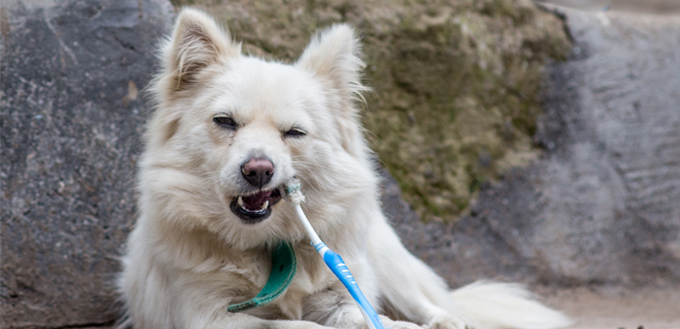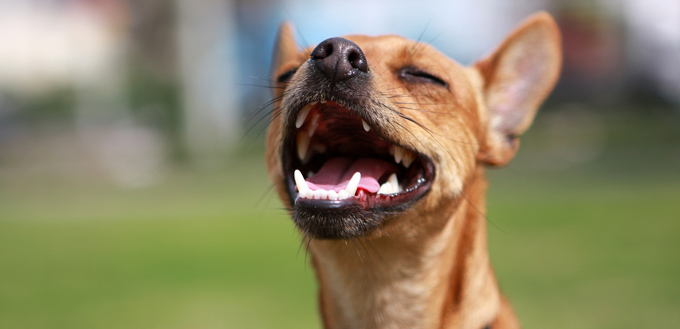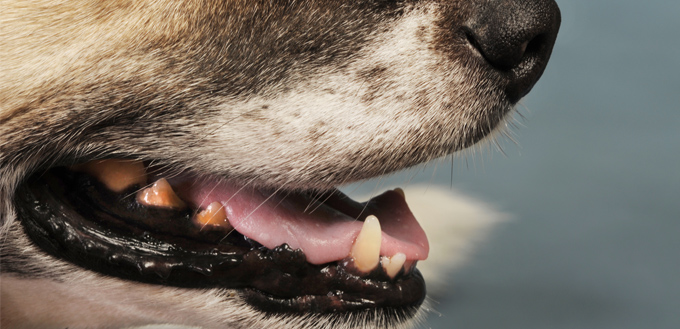Gum disease (periodontal disease) is sadly very common in dogs and causes a lot of pain and discomfort. It is also preventable with appropriate hygiene measures. As a dog owner, this is a subject that you should know about so that you can take measures to prevent it developing in your four-legged friend and seek help if you think your dog has developed gum disease. Here’s a quick guide to the essential information that you should know.

The Origins, Stages and Implications of Gum Disease
Bacteria are the cause of gum disease in humans and animals. The main culprits in dogs are the Streptococcus and Actinomyces bacteria. As soon as food enters the mouth, the bacteria mix with food particles and saliva to form a thin film that adheres to the surface of gums and teeth. This is called plaque. Bacteria happily live in the plaque but the dog’s immune system tries to eliminate them by dispatching white blood cells to the area to fight them off. The white blood cells deliver enzymes to destroy the bacteria but these enzymes also damage soft tissue and even bone and this is gum disease.
Gum disease is a human health problem as well but your pooch is five times more likely to get it than you are! This is because dogs have a more alkaline mouth (less acidic) and this encourages more plaque to form. They also do not brush their teeth every day so the plaque is allowed to build up. You are very likely to see it in an older dog but at least 80 per cent of all dogs have some sort of gum disease by the time they are three years old so young dogs are affected too!
When plaque builds up over a prolonged period of time, it is called a calculus. Minerals combine with it to make it harder. The on-going inflammation of the gum is called gingivitis and causes the gums to look red where they border the teeth. It is the first stage of periodontal disease.
As time goes on, the calculus builds up and causes the gum to separate from the teeth causing a space to form where even more bacteria can grow. This is the advanced stage of gum disease and is irreversible. Sadly, the next stage is bone loss and destruction of the soft tissue as pus forms in the cavities between the gum and teeth.
The stages of gum disease are based on visible signs:
- Stage I: Gums are a bit red and swollen
- Stage II: Cavities (called periodontal pockets) form between the gum and tooth that are over 3mm deep
- Stage III: Periodontal pockets deeper than 5mm form
- Stage IV: More than half of the bone is lost and gums are receding
All dogs can get gum disease but the toy breeds who have small mouths and crowded teeth or dogs with poor tooth alignment are more predisposed to the disease indicating that genetics does have a role to play here. However, there are behavioural factors such as excessive self-grooming and chewing habits that can make gum disease more likely. You can reduce the chances of your pooch getting gum disease by selecting the correct diet and making dental health a priority.
Symptoms of Gum Disease in Dogs
The inflammation and erosion of gum disease cause the loss of soft tissue (gum), bone and teeth. There will be visible changes within the mouth and your dog will be in discomfort but if you do not regularly look in their mouth, you will not know this. They cannot tell you that they are in a bit of discomfort! As a result, the early stages of gum disease usually go undetected. By the time there are symptoms that you will notice, the disease is advanced. Gum disease causes chronic pain and is very distressing for your dog.
The symptoms of advanced periodontal disease can include:
- Bleeding and redness of the gums. You may notice blood in their water or food bowls or notice traces of blood on chew toys and other items that they have been biting
- Difficulty picking up food. They may struggle to get food inside their mouth and so they eat less. They may lose weight as a result.
- Loose teeth. Their teeth may be visibly loose and eventually fall out.
- Bad breath (halitosis). Dogs are not known for having the most fragrant breath! However, if their breath is even smellier than normal it could indicate gum disease.
- When a dog repeatedly opens their mouth and makes a noise, owners sometimes say they are ‘talking’. However, this could be a way of them trying to relieve the discomfort of gum disease. The same is true when they make a noise when they eat or yawn. It may be that opening their mouth is painful.
- Obvious bumps or lumps. If you can see or feel obvious raised areas on the gums, it could indicate gum disease.
- Changes in saliva. The saliva of dogs that have gum disease is often ropey or has blood in it.
- Avoiding physical contact around the head. Most dogs love to be petted anywhere on their body. If they have started to show head shyness (avoidance of you touching their head) it could mean that they are in pain caused by gum disease.
- Changes in the way they chew. Observe how your pooch eats their food. If they are chewing on one side of the mouth only, it may mean that the other side is very painful.
- Changes in the nose. Gum disease in dogs can affect the nose as well as the mouth. You may notice excessive sneezing or nasal discharge. This is because advanced gum disease in the top of the mouth can affect the bone between the mouth and the nasal cavity.
Eventually, the jaw bone can become so weakened by the decay that it fractures. This is called pathologic jaw fracture and may require surgery with plates and wires to fix it. Gum disease in dogs also increases the risk of heart, kidney and liver problems. If you suspect that your doggy has gum disease, it is definitely time to see a vet.

Consulting a Vet About Gum Disease
The sooner you see a vet the better because the prognosis (outcome) for your pooch will be more positive if treatment is started early. Your consultation with your vet about gum disease will involve them having a chat with you to find out some information about your dog, a physical (oral) examination and possibly some further tests.
Information From You
Your vet will ask you about your dog’s symptoms so it may be easier if you write down a list of your concerns. They will also probably ask about their diet and eating habits, their chewing habits and general questions about their age and medical history. You may be asked about the dental hygiene measures, if any, that you currently use on your dog and it is important that you are truthful.
Related Post: Best Chew Toys for Puppies
Oral Examination
Periodontal disease is diagnosed when there are more than two millimetres between the affected gum and the tooth. An initial physical examination will be carried out to see if there is any build-up of tartar and if the gums are inflamed. However, to carry out a proper examination, your dog will need a general anaesthetic.
Prior to the procedure, they will have some blood tests and may be given some antibiotics. Your dog will be booked in for another appointment when they will be anaesthetised and a full dental examination carried out. Any teeth that cannot be saved will be extracted. The build-up of tartar will be scraped off and the teeth will be thoroughly cleaned and polished.
A special periodontal probe will be used to measure the presence and depth of pockets between the teeth and the gums to determine if it is over two millimetres.
Further Tests
Even a detailed oral examination under anaesthetic will not reveal the full extent of the problem because more than half of the damage is hidden under the gum line. Therefore, dental x-rays are needed to give your vet a complete picture of what is going on. The x-rays will show any loss of density of the bone due to periodontal disease and will show the sharpness of the root socket. When the disease is more advanced, it will show how much bone has been lost.
Treatment of Gum Disease
The start of most treatment regimes is the extraction procedure and scale and polish under general anaesthetic. However, further surgical work may be needed. It could be carried out during the initial or during subsequent operations. The treatment plan for stage I or II periodontal disease is simply a thorough dental clean both above and below the gumline to remove the plaque. An ultrasonic scaler can be used to remove the tartar which is harder. A dental polish is used to fill in the crevices on teeth so that bacteria and plaque do not build up as easily.
If your vet discovers that your dog has stage III gum disease, they may have to expose the bone by cutting through the gum and cleaning out the diseased bone and soft tissue. There are cutting-edge techniques that can now grow new tissue and bone to replace what has been cut out.
For stage IV, there are several treatment options. Your vet may choose to plane the diseased area or cut out the diseased socket (subgingival curettage). The tartar, the diseased tooth and diseased tissue will all be removed. A gingivectomy may be performed which is the removal of excess or diseased gum tissue.
After surgery, your pooch may have slow-release antibiotics, sealants and bone growth stimulants to help with healing and repair. You will almost certainly need to attend some follow-up appointments to see how things are going. In the first few weeks after surgery, your doggy will need pain medication to keep them comfortable and antibiotics to make sure that infections don’t occur in the mouth and elsewhere in the body.
They will probably need a soft diet for a while or you could try soaking their regular kibble in warm water to make it easy to chew. They will not be able to play with hard chew toys for around a month after surgery whilst the gums heal.

Living With Your Dog’s Gum Disease
It is not possible to reverse the damage that has already been caused by gum disease. However, once appropriate treatment has been carried out by your vet, you can do your part to control the situation and to make sure that further disease does not establish.
Preventative dental hygiene measures for periodontal disease can include:
- Healthy diet. Sugary and sticky food can damage a dog’s teeth just the same as in humans. Switch your dog onto a ‘dental diet’ that will scrub their teeth as they eat and scrape off the plaque. Other foods have additives that prevent plaque from hardening on the teeth. Your vet can advise you on the best diet.
You May Also Like: Dog Chews
Regular tooth brushing. You will need to brush your dog’s teeth twice a day with special animal toothpaste and a soft dog toothbrush. The toothpaste is made in flavours that dogs enjoy so hopefully they will come to enjoy this activity! Start with just a few seconds of brushing and then build up the time as they get used to it.
- Chew toys. Regular chewing on an appropriate toy will help to scrape off plaque.
- Dental treats. These are specially designed for dental health and a lot better for your dog than unhealthy treats.
- Regular dental check-ups. It is important that you take your pooch for regular oral examinations. Your vet will also book you in for annual cleaning sessions to remove any build-up of tartar. There may be a need for further x-rays.
Related Post: Best Dental Chews for Dogs
Sources:
- Gum Disease in Dogs, Wag!
- Dr.Elizabeth McCalley, Gum Disease in Dogs, PetMD
- Wendy C. Fries, The Perils of Gum Disease in Dogs, WebMD
Note: The advice provided in this post is intended for informational purposes and does not constitute medical advice regarding pets. For an accurate diagnosis of your pet's condition, please make an appointment with your vet.






